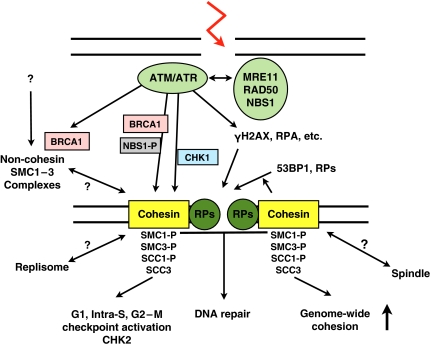Figure 1.
Model for the functions of cohesin in the DNA damage response. DNA damage sensors (ATM, ATR, and the MRE11–RAD50–NBS1 complex) are activated in G1, S, and/or G2–M phase. In S, phosphorylated NBS1 allows ATM to phosphorylate SMC1, possibly SMC3. In G2–M, ATR activates CHK1, which phosphorylates SCC1, causing an increase in genome-wide cohesion. Polo-like kinase phosphorylation of SCC3 may have to be prevented. The model excludes neither overlapping actions of proteins in different checkpoints nor multiple effects of cohesin phosphorylation. The distinction between cohesin and repair proteins (RPs) is for illustrative purpose only, as cohesin takes part in the repair reaction itself. Recruitment of some RPs depends on cohesin. The SMC5–SMC6 complex, included in ‘RPs', loads at DNA breaks. Cohesin-loading factors are not represented. How non-cohesin SMC1–SMC3-based complexes relate to cohesin, and when and where such complexes exist is unknown. It is also unclear whether DNA damage-activated cohesin affects the replisome, for example, by slowing replication, or even spindle formation. How cohesin controls checkpoint function also remains to be described. Assemblies at both ends of the broken DNA are supposed to be identical and are drawn differently only for the purpose of illustration.

